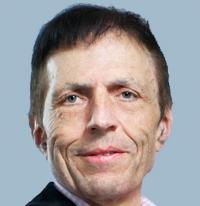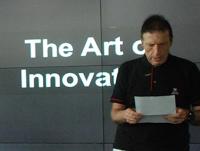Professor Jürg Gutknecht, ehemaliger Vorsteher des Departements Informatik der ETH Zürich und designierter Präsident der Schweizer Informatik Gesellschaft SI, hielt kürzlich seine Abschiedsvorlesung an der ETH Zürich. Monika Ruth führte mit Gutknecht, der zusammen mit Niklaus Wirth die Programmiersprache Oberon und das gleichnamige Betriebssystem entwickelt hat, nachfolgendes Interview. Das Gespräch erfolgte auf Englisch.
Von Monika Rut (Mitarbeiterin Kommunikation Informatikdepartement ETH)
“Make it as simple as possible but not simpler”: led by this principle Jürg Gutknecht and Niklaus Wirth embarked on their first project, Oberon. It was 1981 and the young mathematician Gutknecht was fascinated by the “crystal-clear logic of programming”. This was the starting point of a life-long journey. Driven by cross-disciplinary approaches and the quest for practical proof of his research concepts, Prof. Gutknecht built up numerous partnerships and ventured into areas such as computer-aided art. As University Professor and Head of the Department of Computer Science, he was influential in the educational establishment and growth of the department. Today, as an advocate for informatics in schools, Prof. Gutknecht’s main concern is to raise the level of awareness of computer literacy as a skill of the contemporary world.
Monika Rut: Entering ETH as a student of Mathematics and leaving it as Professor of Computer Science you have climbed the institutional ladder with dedication and elegance. Is this success a result of logical thinking or is it simply that mathematicians are infallible?
Jürg Gutknecht: Well, in reality it is quite a bit more complicated than one might think. In fact, it was a long walk that started years before I entered ETH as a student of Mathematics and that took many detours later on. I began at Swissair in the pioneering days of computing, where I soon became fully responsible for the Airline Control Program (ACP). Later, as a student and working at IBM, I developed a quickly growing interest in Mathematics. Having received my doctorate, I first focused entirely on teaching. Years went by and one day, I heard about an advertisement from Prof. Wirth, who was looking for someone to participate in his Lilith/ Modula workstation project. My decision to apply was driven by pure curiosity. Similar to the famous man who just wanted to go around the corner and pick up his mail but then went on a long journey, my application emerged into a life-long journey. As if it was yesterday, I remember how immediately enthused and fascinated I was when I saw a demo of the Lilith computer for the first time. It was a fridge-sized box and a screen in portrait format featuring a bitmap display, windows, mouse, etc. From that moment on, I knew that I wanted to participate actively in this new era of (personal) computing, a decision that I have never regretted (even though I had to give up my tenure in teaching for a temporary employment). A few years later and after a sabbatical stay at the charismatic Xerox PARC in California, Prof. Wirth and I engaged in project Oberon. Coming back now to your actual question: In all my choices, I somehow intuitively took the right decision at the right time, in most cases in favor of leaving the old and beloved path for a new adventure. Furthermore, I was lucky enough to convince a handful of important people who contributed to my professional life, and who helped me to take the next meaningful steps up the ladder of my career.
Your early research focused on Oberon. Later, you continued with programming languages, compilers and runtime platforms. If it’s true, as Edsger Dijkstra said, that programming is one of the most difficult branches of applied mathematics, could you tell us what distinguishes your research from that of others?
JG: During my time as a student of Mathematics, I also became interested in Theoretical Physics, and I even worked at the department as an assistant. However, after a while I realized that, in spite of its mathematical nature, the field was actually lacking the transparence and the principal clarity that I knew from computing. Textbooks and papers were full of rather dubious tricks such as “renormalization of diverging infinite sums” that had to be applied in order to achieve reasonable results. I was starting to long for the “crystal-clear logic of programming”, where right and wrong was decidable by a neutral arbiter called the computer. With time passing, my research focused on building systems (in particular operating systems) according to the principles of elegance, simplicity, clarity and resource efficiency. These systems were based on uncompromising lean and clean designs and utmost transparence. This approach was amply paying off in terms of teachability, efficiency and reliability. In this connection, I would like to point out the lightning-fast response time (significantly below 0.1 seconds) of even the early Ceres/ Oberon computers that were running at a mere 10 MHz clock rate! In addition to that, the Oberon system was compact enough to be fully understood and maintained by a single person, and it was ultimately reliable on a 24/7 basis. All these factors caused interest in Oberon by individual industries with particularly high demands in terms of safety and dependability. Under the name of Swiss Industry Controller, Oberon is still today productively used, for example, by a world-leading company specialized in the production of high-precision extruders. In my later years, I became more and more interested in technically challenging applications that would provide some practical proof to my systems research concepts. This is why I chose digital arts and medical projects as vehicles to apply generic system research to specific challenges that would go beyond the capabilities of off-the-shelf systems.
From 2006 - 2010 you were department head. What does this position mean and did you have a chance to affect the future of the department?
JG: My responsibilities as department head were very challenging indeed. As a “primus inter pares”, I had to find a critical mass of like-minded colleagues before having any chance of getting an idea approved. During my term, I experienced three different interfaces to the upper management, viz. three different ETH Presidents. Also, there was a number of very special activities to take care of, among them the 25 year anniversary celebration of Informatics at ETH, the Swiss Year of Informatics, the move to and the reunion in the CAB building and, last but not least, the (external) evaluation of the department’s performance. Arguably, hiring new faculty is the most noble and most sustainable of all tasks of a department head. I was lucky enough to get a number of first class people on board, in particular including the current department head. Speaking of what I consider as my achievements, it is probably fair to say that, together with my deputy Prof. Gonnet, the studies delegate Prof. Buhmann, and the executive committee, I took the initiative and laid the ground for the following developments: the Microsoft Innovation Cluster, a Medical Informatics Competence Center in partnership with the University Hospital, strategic support of educational initiatives in Informatics in the Schools, a new hiring system and a consolidated and improved curriculum (introduction of Parallel Programming into the Bachelor program, cross-cutting courses at Master’s level, and strategic awareness of service lecturing).
The Native Systems Group was instrumental in the development of the “Supercomputer in Pocket” supported by the Microsoft Innovation Cluster for Embedded Software. What can you say about finding the perfect match with the industry in terms of a partnership which strives toward a sustainable approach to research and continues to attract top scientists?
JG: During my time at ETH, I came into contact with Microsoft coincidentally in a variety of very different contexts. After a few years of lobbying and thanks to special circumstances, the desired partnership finally (and suddenly) became a reality in the form of an Innovation Cluster. Consequently, I was one of the founding members together with my colleague Prof. Zwaenepoel from EPFL. The Supercomputer in the Pocket project was about a new level of holistic systems design. While the Native Systems Group has always tried to keep up Prof. Wirth’s tradition and philosophy of an integrated design jointly made of building systems, languages and compilers from the ground up, a new generation of programmable hardware (FPGA) made it possible to include the hardware layer in the system (co-) design process in the first place, in contrast to earlier approaches based on mapping the application to some existing hardware architecture. The major challenge that we tackled with this project was to develop an Integrated Development Environment (IDE), later called “Active Cells”, that allowed even non-hardware-literates to express an entire system including the underlying hardware in the form of a single, comprehensive high-level programming language. What can I say about finding a perfect match with industry in terms of a successful partnership? Maybe the most important criterion is finding a project of genuine interest to both partners. While formal agreements have become a science of their own, a solution can always be found in matters where interest cannot be generated artificially. What are the benefits of such a partnership? Perhaps, surprisingly, my answer is: To be connected to the real world in the first place, to be more than the sum of its parts in terms of research competence in the second place, and financial benefits in the third place only. For example, spending some time on the Microsoft campus in Redmond as a summer intern is an unforgettable, eye-opening experience for any student.
Albert Einstein said that, “all religions, arts, and sciences are branches of the same tree”.You have been working with various creative people over the years. Does working with artists through technology impact your approach to teaching and research in any way?
JG: In the early Lilith times, we were in urgent need of a professional typographer who would design fonts for us, which meant patiently sitting at a computer screen and drawing character by character with the mouse in a WYSIWYG way (“what you see is what you get”). After some amazing detour to California we got introduced to Hans Meier, an internationally well-known typographer, who was teaching right around the corner at the Museum für Gestaltung (Museum of Design) in Zurich. In the years to follow, Meier contributed to the Lilith project not merely with high-quality digital fonts of international recognition, but he also substantially supported two doctoral students with his professional advice. As a matter of fact, in this as in all my later science-art collaborations, the science aspect of computing was prominently represented. My later involvement in the digital arts included “domain specific languages” and "wearable computing" in projects such as “Artwork Code”, “Instant Gain in Grace” (motion tracking of a Butoh dancer), “Going Publik” (distributed orchestra based on mobile electronic scoring), and “On the Sixth Day” (multi-channel video system for interactive storytelling). The major incentive underlying all my digital arts activities was delivering a proof of some concept of our systems research. Did working with artists have an impact on my approach to teaching? I would not say that digital arts have influenced my teaching directly, but they surely have enriched my research work and attracted numerous students, including a substantial number of female students, who would have otherwise never had an interest in our research work, and which chose our lab for doing their theses.
“The scientific world of the future will be pairs, or connections, everybody is going to be a bridge between specialties”, said Donald Kunth. You have been nurturing art and science collaborations such as the Digital Art Weeks for years now. If it’s true that innovations are generated through transdisciplinary projects and globally networked partnerships, what should a university per se do to cultivate such a trend in the future?
JG: First of all, universities should continue to provide a first-class education in the different fundamental disciplines. I am not a fan of people jumping on the transdisciplinary bandwagon because they don’t succeed in the harsh reality of their own field. Having said this, I like Knuth’s metaphoric picture of building bridges. This should perhaps be cultivated and supported by universities more explicitly, for example in the form of a matrix-like structure, rich enough to represent interdepartmental competence centers as fully valued organizational units. However, every bridge connects two partners standing on firm ground, and it does not make sense otherwise. In addition to what you mentioned, I have tried to build a bridge between academia and practice with the support of our alumni. The lecture “Fallstudien aus der Praxis” serves exactly this purpose, and it can be considered a success.
“Publish or perish” describes the pressure in academia to rapidly publish a large number of papers. Despite this situation, is freedom, variety, and creativity in academic research being compromised for international rankings or individual careers?
JG: Creativity is the alpha and omega of every research and for me the very root of excellent research. When I was involved in the Lilith project, sheer excitement was radiating through the corridors, and the office lights never went out. Building such an innovative computer was a highly creative act and everybody fell under its spell. The motivation was genuine and primary, and numerous journal publications emerged from a real need to explain design decisions, approaches, and experiences made. In a “publish-or-perish” realm it would be just the other way around: the actual construction would be of secondary importance, while publications would play the major role. This kind of inversion of priorities does not come without consequences. Edsger W. Dijkstra said, “science is not about competition, it is about perfection”. Almost by definition, any efforts towards perfection will be concentrated on the meta-level of publications in a “publish-or-perish” land on the cost of the quality of the actual construction, because it is of no interest to anyone and hardly ever will anyone cross-check it. However, we need to remember that we are a constructive science as is architecture, and this is very different from the natural sciences, for example. In a constructive science, the usefulness and elegance of the actual constructions should stand above their verbose descriptions and all the promises.
“Putting a computer in front of a child and expecting the computer to teach the child is like putting a book under its pillow, but only more expensive”, said Joseph Weizenbaum. How can we win over stakeholders and convince politicians to support initiatives like “Informatics in the Schools”?
JG: I truly admire Weizenbaum for his wisdom, and I agree that computers will never generate any learning effect by their sheer presence. However, if used properly, computers are powerful tools that can make good teaching better, by, for example, exhibiting interactive behavior or via an online course (MOOCS) approach. Still, we are well-advised to remember that contents are generated by real people and that computers are merely used to produce representations of these contents, however fancy they may be. Joseph Weizenbaum is definitely wrong with his remark regarding the costs. At the CeBIT in Hannover this year, I bought a fully-fledged tablet computer for 40 Euros, which is surely less than the price of a decent pillow. Coming back now to your actual question: I have recently become involved in the initiative “Informatics in the Schools”, and I must sadly say that a lot of ignorance and confusion still reigns in this domain. Even among the decision makers (and worse, among the experts!) interpretations of what “Informatics” means ranges from classical type-writing and using text processing systems to media pedagogy and all the way up to programming and computational thinking. Undoubtedly, we need to first educate the stakeholders before making any attempt to convince them of the importance of informatics and computational education. While many see information as the oil of the 21st century, governments still have widely failed to realize that education in informatics deserves a top position on their strategic agenda. Even in Switzerland, with its decentralized school system, the government should take a top-down initiative and give a mandate to the experts with the mission of clarifying technical terms and coming up with a proposal of informatics contents to be taught that fits on five pages or so.
Following Emerson’s words “life is a journey, not a destination”, where will your life’s journey be bringing you in the future?
JG: As the saying goes, „prediction is difficult, especially if it concerns the future”. I will look for opportunities and advantageous circumstances. My professional goal right now is to strengthen the position of the Swiss Informatics Society (SI) within the socio-economic and political landscape of Switzerland. Again, in connection with my involvement in SI, I would like to help advance the “Informatics in the Schools” initiative as well as strategic initiatives in Life-Long-Learning and in creating a comprehensive Digital Agenda. Another urgent concern is finalizing the BEC project (Beijing ETH Competence Center with a focus on Medical Informatics). And, because I want to remain creative, I have started to develop apps, the first one being a Jukebox controller for the NOVA digital sculpture located in the CAB FoodLab. Last but not least, I want to continue learning, deepening my understanding and widening my horizon within computer science, across other sciences and on higher spiritual levels.
Links:
Native System group: http://www.nativesystems.inf.ethz.ch/JuergGutknecht
Informatik und die Schule des 21. Jahrhunderts: http://www.multimedia.ethz.ch/misc/2013/schule
Swiss Informatics Society: http://www.s-i.ch/en/
Digital Art Weeks: www.digitalartweeks.ethz.ch/web/



